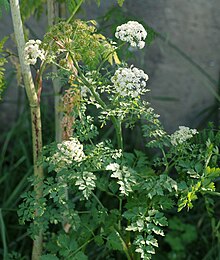| Oenanthe | |
|---|---|

| |
| Oenanthe aquatica | |
| Scientific classification | |
| Kingdom: | Plantae |
| Clade: | Tracheophytes |
| Clade: | Angiosperms |
| Clade: | Eudicots |
| Clade: | Asterids |
| Order: | Apiales |
| Family: | Apiaceae |
| Subfamily: | Apioideae |
| Tribe: | Oenantheae |
| Genus: | Oenanthe L. |
| Synonyms[1] | |
|
List
| |

Oenanthe, known as water dropworts, oenanthes,[2] water parsleys,[3] and water celeries,[4] are a genus of plants in the family Apiaceae. Most of the species grow in damp ground, such as in marshes or in water.
Several of the species are extremely poisonous, the active poison being oenanthotoxin. The most notable of these is O. crocata, which lives in damp, marshy ground, and resembles celery with roots like a bunch of large white carrots. The leaves may be eaten safely by livestock, but the stems, and especially the carbohydrate-rich roots are much more poisonous. Animals familiar with eating the leaves may eat the roots when these are exposed during ditch clearance: one root is sufficient to kill a cow, and human fatalities are also known. It has been referred to as the most poisonous of all British plants,[5] and is considered particularly dangerous because of its similarity to several edible plants.[6]
The species O. javanica, commonly known as Chinese celery or Japanese parsley (seri; not to be confused with mitsuba or Japanese wild celery, Cryptotaenia japonica) is edible and grown in several countries of eastern Asia, as well as in Italy and India, where the spring growth is relished as a vegetable.
- ^ Cite error: The named reference
powowas invoked but never defined (see the help page). - ^ Cite error: The named reference
calscapewas invoked but never defined (see the help page). - ^ Cite error: The named reference
vascanwas invoked but never defined (see the help page). - ^ Cite error: The named reference
ilwildwas invoked but never defined (see the help page). - ^ "Information Sheet: 31 Hemlock Water Dropwort (Oenanthe crocata)" (PDF). Centre for Ecology and Hydrology. 2005. Retrieved September 28, 2011.
Oenanthe crocata [...] is the most toxic plant in Britain to both humans and animals.
- ^ Wright, John (2010), Hedgerow, Bloomsbury, p. 171, ISBN 978-1-4088-0185-7